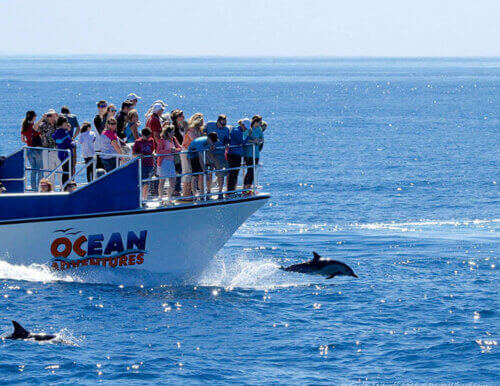How Dana Wharf Captains and Guides Find Whales: Skill, Tech & Experience at Work

Whale watching is never just about luck—especially not at Dana Wharf. With decades of experience navigating the waters off Dana Point, the captains and marine naturalists at Dana Wharf Whale Watching have fine-tuned the art and science of finding whales.
From cutting-edge technology to deep local knowledge, here’s how our team consistently delivers unforgettable whale and dolphin sightings year-round.
Decades of Local Experience
One of the biggest advantages of choosing Dana Wharf is the seasoned expertise of our captains. Many have spent years—some, decades—navigating the same coastal waters. This experience gives them an unmatched understanding of whale behavior, seasonal migration patterns, and how ocean conditions impact marine life movement.
They know where whales like to travel, feed, and rest depending on the time of year and even the time of day. This local familiarity leads to more accurate decisions when planning routes and identifying hot spots.
Networking on the Water: A Community of Spotters
Dana Wharf is part of a tight-knit network of whale watching and sportfishing vessels that share real-time sightings. Captains frequently communicate via radio to report where whales and large pods of dolphins are located.
This collaboration allows our boats to respond quickly and reposition when needed—helping maximize your chances of seeing marine life no matter where you are on the water.
Marine Naturalists Onboard Every Trip
Every Dana Wharf whale watching tour includes a professional marine naturalist. These experts not only educate guests on whale species and behaviors, but also serve as skilled spotters. Their trained eyes are adept at noticing subtle movements on the horizon, distant spouts, or feeding frenzies that indicate whale or dolphin activity.
They also monitor the behavior of seabirds and bait fish, which often signal where whales may be hunting below the surface.
Technology That Enhances Sightings
While experience is key, modern tech helps too. Captains often use:
-
Binoculars and spotting scopes to track distant blows or flukes.
-
GPS and navigation systems to monitor whale movement history and optimize routes.
-
Fish finders and sonar to locate bait balls and underwater activity that often attracts feeding whales and dolphins.
These tools help crews quickly assess the environment and make informed decisions while out at sea.
Daily Whale Sightings Logs
Dana Wharf maintains a daily sightings log, which helps the crew track trends in animal behavior over time. This database includes species spotted, locations, time of day, and weather conditions. It’s a valuable resource that supports trip planning and improves the odds of successful sightings for future tours.
Guests can view this log online, so you know what’s been seen lately and what to expect.
Why This Matters for You
When you book a whale watching trip, you want more than just a boat ride—you want the best possible chance to see whales and other marine life. Dana Wharf’s combination of technology, teamwork, and decades of experience makes that possible.
Our captains and guides don’t just hope to find whales—they know how to find them.


